Talent Management: Attracting and Selecting Employees Report
VerifiedAdded on 2020/01/28
|12
|3090
|89
Report
AI Summary
This report delves into the critical role of talent management in contemporary organizations, emphasizing its significance in satisfying both current and future human capital needs. It defines talent management, tracing its emergence as a vital approach within Human Resource Management to ensure businesses are equipped with suitable employees. The report explores the challenges of attracting and retaining talent in a competitive global environment, highlighting strategies such as offering competitive salaries, developing talent management systems, and fostering employee development. It emphasizes the benefits of focusing on internal talent development over external recruitment, underscoring the importance of aligning talent management with overall business strategies to achieve organizational success. The report also discusses the effectiveness of these strategies in achieving talent management objectives, such as sourcing, attracting, recruiting, and retaining qualified candidates, ultimately enhancing an organization's competitive advantage and strategic positioning.
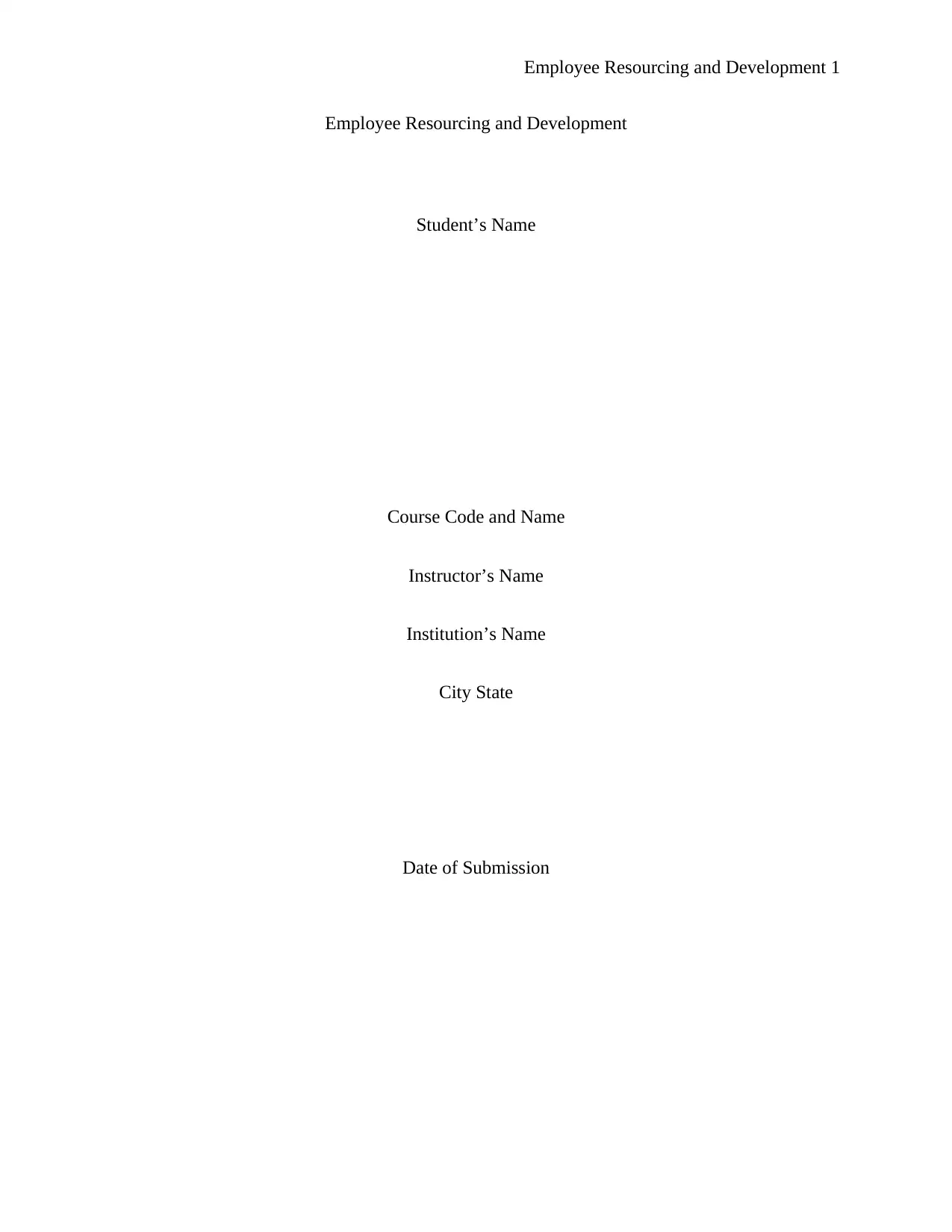
Employee Resourcing and Development 1
Employee Resourcing and Development
Student’s Name
Course Code and Name
Instructor’s Name
Institution’s Name
City State
Date of Submission
Employee Resourcing and Development
Student’s Name
Course Code and Name
Instructor’s Name
Institution’s Name
City State
Date of Submission
Paraphrase This Document
Need a fresh take? Get an instant paraphrase of this document with our AI Paraphraser
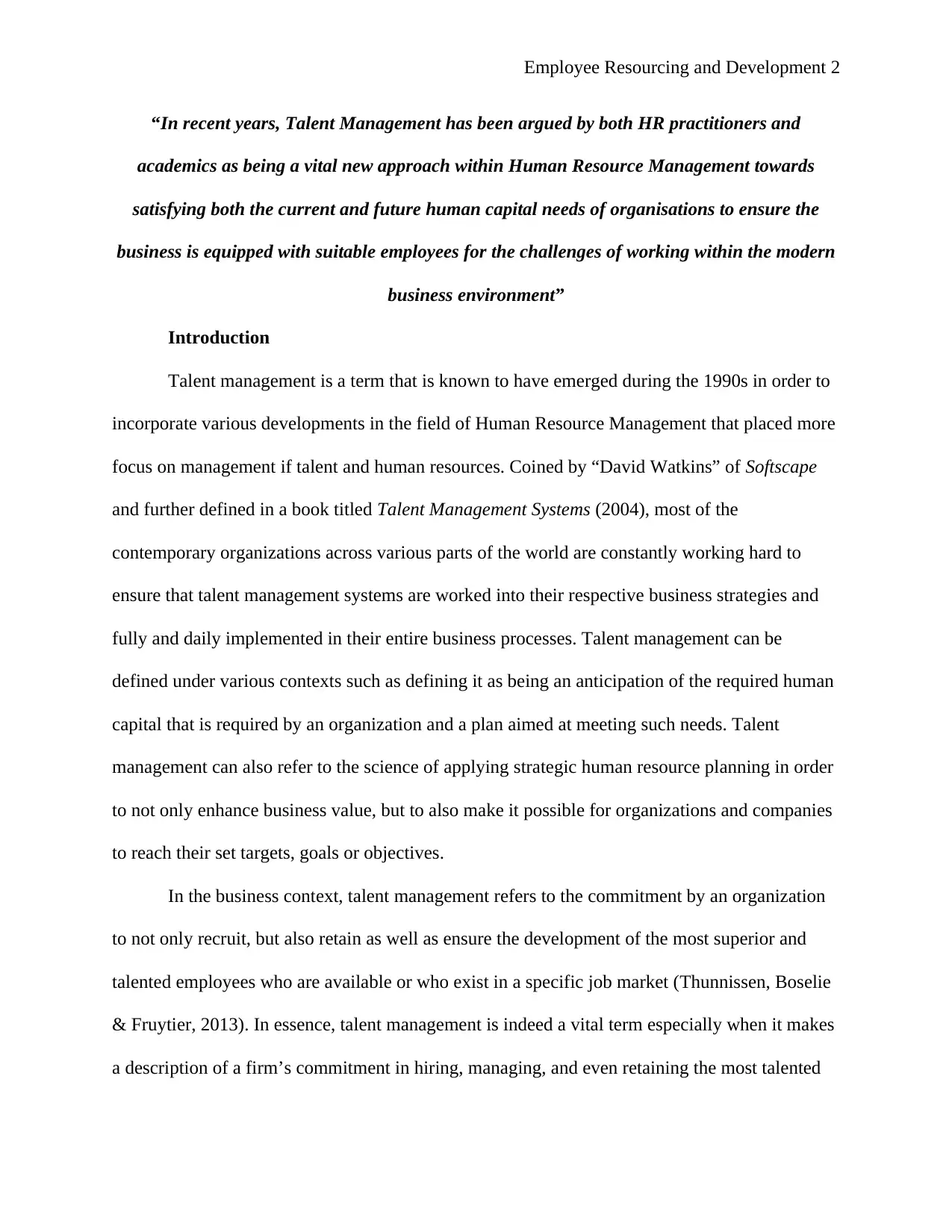
Employee Resourcing and Development 2
“In recent years, Talent Management has been argued by both HR practitioners and
academics as being a vital new approach within Human Resource Management towards
satisfying both the current and future human capital needs of organisations to ensure the
business is equipped with suitable employees for the challenges of working within the modern
business environment”
Introduction
Talent management is a term that is known to have emerged during the 1990s in order to
incorporate various developments in the field of Human Resource Management that placed more
focus on management if talent and human resources. Coined by “David Watkins” of Softscape
and further defined in a book titled Talent Management Systems (2004), most of the
contemporary organizations across various parts of the world are constantly working hard to
ensure that talent management systems are worked into their respective business strategies and
fully and daily implemented in their entire business processes. Talent management can be
defined under various contexts such as defining it as being an anticipation of the required human
capital that is required by an organization and a plan aimed at meeting such needs. Talent
management can also refer to the science of applying strategic human resource planning in order
to not only enhance business value, but to also make it possible for organizations and companies
to reach their set targets, goals or objectives.
In the business context, talent management refers to the commitment by an organization
to not only recruit, but also retain as well as ensure the development of the most superior and
talented employees who are available or who exist in a specific job market (Thunnissen, Boselie
& Fruytier, 2013). In essence, talent management is indeed a vital term especially when it makes
a description of a firm’s commitment in hiring, managing, and even retaining the most talented
“In recent years, Talent Management has been argued by both HR practitioners and
academics as being a vital new approach within Human Resource Management towards
satisfying both the current and future human capital needs of organisations to ensure the
business is equipped with suitable employees for the challenges of working within the modern
business environment”
Introduction
Talent management is a term that is known to have emerged during the 1990s in order to
incorporate various developments in the field of Human Resource Management that placed more
focus on management if talent and human resources. Coined by “David Watkins” of Softscape
and further defined in a book titled Talent Management Systems (2004), most of the
contemporary organizations across various parts of the world are constantly working hard to
ensure that talent management systems are worked into their respective business strategies and
fully and daily implemented in their entire business processes. Talent management can be
defined under various contexts such as defining it as being an anticipation of the required human
capital that is required by an organization and a plan aimed at meeting such needs. Talent
management can also refer to the science of applying strategic human resource planning in order
to not only enhance business value, but to also make it possible for organizations and companies
to reach their set targets, goals or objectives.
In the business context, talent management refers to the commitment by an organization
to not only recruit, but also retain as well as ensure the development of the most superior and
talented employees who are available or who exist in a specific job market (Thunnissen, Boselie
& Fruytier, 2013). In essence, talent management is indeed a vital term especially when it makes
a description of a firm’s commitment in hiring, managing, and even retaining the most talented
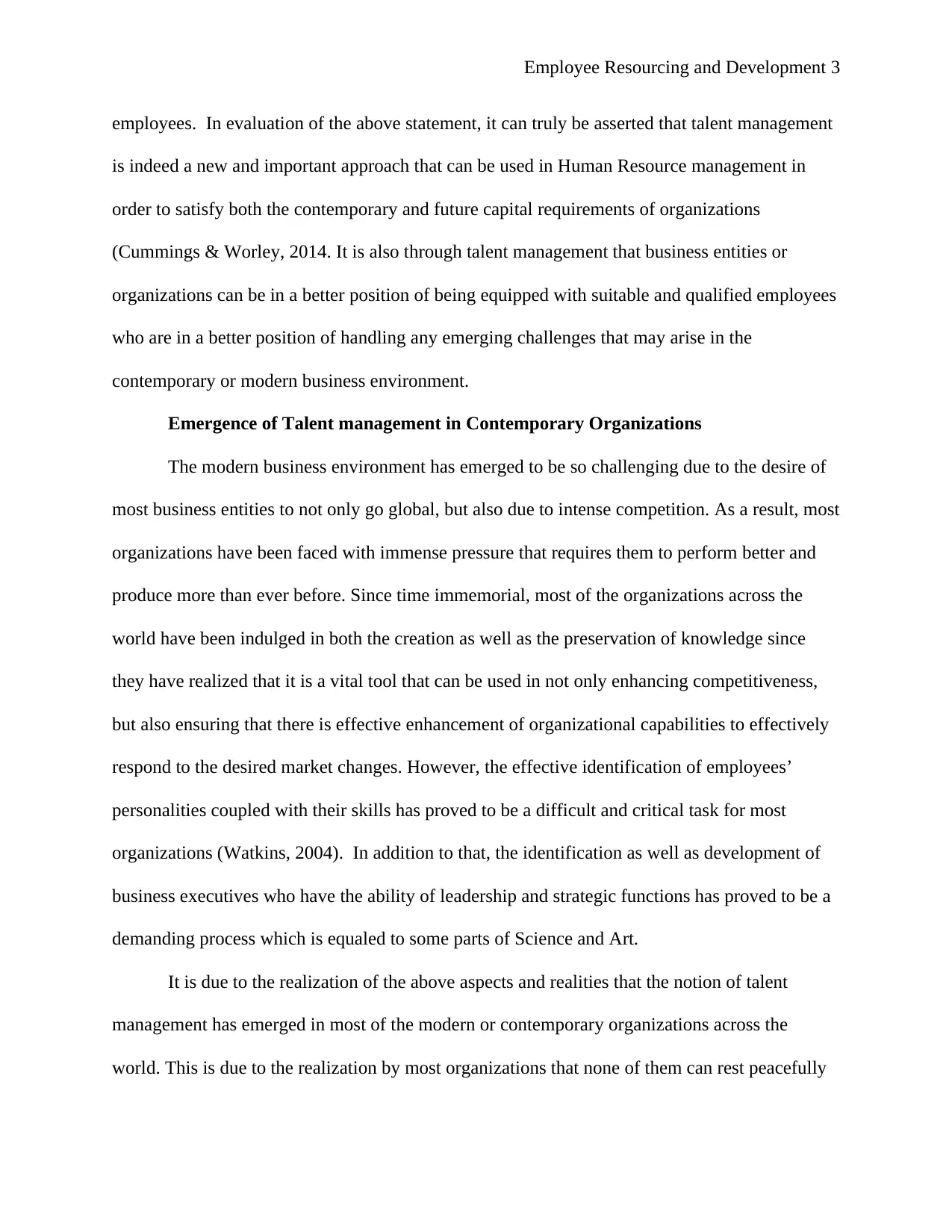
Employee Resourcing and Development 3
employees. In evaluation of the above statement, it can truly be asserted that talent management
is indeed a new and important approach that can be used in Human Resource management in
order to satisfy both the contemporary and future capital requirements of organizations
(Cummings & Worley, 2014. It is also through talent management that business entities or
organizations can be in a better position of being equipped with suitable and qualified employees
who are in a better position of handling any emerging challenges that may arise in the
contemporary or modern business environment.
Emergence of Talent management in Contemporary Organizations
The modern business environment has emerged to be so challenging due to the desire of
most business entities to not only go global, but also due to intense competition. As a result, most
organizations have been faced with immense pressure that requires them to perform better and
produce more than ever before. Since time immemorial, most of the organizations across the
world have been indulged in both the creation as well as the preservation of knowledge since
they have realized that it is a vital tool that can be used in not only enhancing competitiveness,
but also ensuring that there is effective enhancement of organizational capabilities to effectively
respond to the desired market changes. However, the effective identification of employees’
personalities coupled with their skills has proved to be a difficult and critical task for most
organizations (Watkins, 2004). In addition to that, the identification as well as development of
business executives who have the ability of leadership and strategic functions has proved to be a
demanding process which is equaled to some parts of Science and Art.
It is due to the realization of the above aspects and realities that the notion of talent
management has emerged in most of the modern or contemporary organizations across the
world. This is due to the realization by most organizations that none of them can rest peacefully
employees. In evaluation of the above statement, it can truly be asserted that talent management
is indeed a new and important approach that can be used in Human Resource management in
order to satisfy both the contemporary and future capital requirements of organizations
(Cummings & Worley, 2014. It is also through talent management that business entities or
organizations can be in a better position of being equipped with suitable and qualified employees
who are in a better position of handling any emerging challenges that may arise in the
contemporary or modern business environment.
Emergence of Talent management in Contemporary Organizations
The modern business environment has emerged to be so challenging due to the desire of
most business entities to not only go global, but also due to intense competition. As a result, most
organizations have been faced with immense pressure that requires them to perform better and
produce more than ever before. Since time immemorial, most of the organizations across the
world have been indulged in both the creation as well as the preservation of knowledge since
they have realized that it is a vital tool that can be used in not only enhancing competitiveness,
but also ensuring that there is effective enhancement of organizational capabilities to effectively
respond to the desired market changes. However, the effective identification of employees’
personalities coupled with their skills has proved to be a difficult and critical task for most
organizations (Watkins, 2004). In addition to that, the identification as well as development of
business executives who have the ability of leadership and strategic functions has proved to be a
demanding process which is equaled to some parts of Science and Art.
It is due to the realization of the above aspects and realities that the notion of talent
management has emerged in most of the modern or contemporary organizations across the
world. This is due to the realization by most organizations that none of them can rest peacefully
⊘ This is a preview!⊘
Do you want full access?
Subscribe today to unlock all pages.

Trusted by 1+ million students worldwide
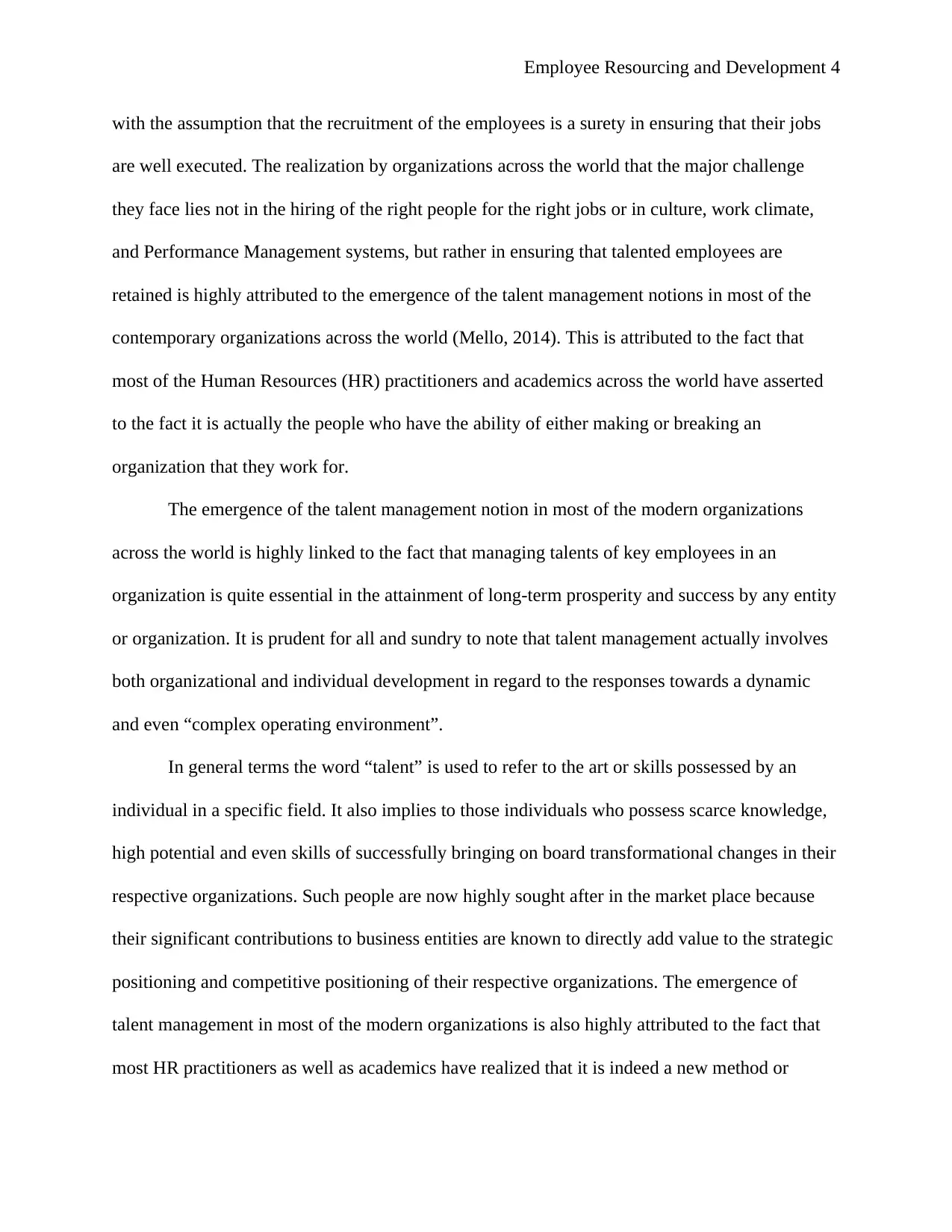
Employee Resourcing and Development 4
with the assumption that the recruitment of the employees is a surety in ensuring that their jobs
are well executed. The realization by organizations across the world that the major challenge
they face lies not in the hiring of the right people for the right jobs or in culture, work climate,
and Performance Management systems, but rather in ensuring that talented employees are
retained is highly attributed to the emergence of the talent management notions in most of the
contemporary organizations across the world (Mello, 2014). This is attributed to the fact that
most of the Human Resources (HR) practitioners and academics across the world have asserted
to the fact it is actually the people who have the ability of either making or breaking an
organization that they work for.
The emergence of the talent management notion in most of the modern organizations
across the world is highly linked to the fact that managing talents of key employees in an
organization is quite essential in the attainment of long-term prosperity and success by any entity
or organization. It is prudent for all and sundry to note that talent management actually involves
both organizational and individual development in regard to the responses towards a dynamic
and even “complex operating environment”.
In general terms the word “talent” is used to refer to the art or skills possessed by an
individual in a specific field. It also implies to those individuals who possess scarce knowledge,
high potential and even skills of successfully bringing on board transformational changes in their
respective organizations. Such people are now highly sought after in the market place because
their significant contributions to business entities are known to directly add value to the strategic
positioning and competitive positioning of their respective organizations. The emergence of
talent management in most of the modern organizations is also highly attributed to the fact that
most HR practitioners as well as academics have realized that it is indeed a new method or
with the assumption that the recruitment of the employees is a surety in ensuring that their jobs
are well executed. The realization by organizations across the world that the major challenge
they face lies not in the hiring of the right people for the right jobs or in culture, work climate,
and Performance Management systems, but rather in ensuring that talented employees are
retained is highly attributed to the emergence of the talent management notions in most of the
contemporary organizations across the world (Mello, 2014). This is attributed to the fact that
most of the Human Resources (HR) practitioners and academics across the world have asserted
to the fact it is actually the people who have the ability of either making or breaking an
organization that they work for.
The emergence of the talent management notion in most of the modern organizations
across the world is highly linked to the fact that managing talents of key employees in an
organization is quite essential in the attainment of long-term prosperity and success by any entity
or organization. It is prudent for all and sundry to note that talent management actually involves
both organizational and individual development in regard to the responses towards a dynamic
and even “complex operating environment”.
In general terms the word “talent” is used to refer to the art or skills possessed by an
individual in a specific field. It also implies to those individuals who possess scarce knowledge,
high potential and even skills of successfully bringing on board transformational changes in their
respective organizations. Such people are now highly sought after in the market place because
their significant contributions to business entities are known to directly add value to the strategic
positioning and competitive positioning of their respective organizations. The emergence of
talent management in most of the modern organizations is also highly attributed to the fact that
most HR practitioners as well as academics have realized that it is indeed a new method or
Paraphrase This Document
Need a fresh take? Get an instant paraphrase of this document with our AI Paraphraser
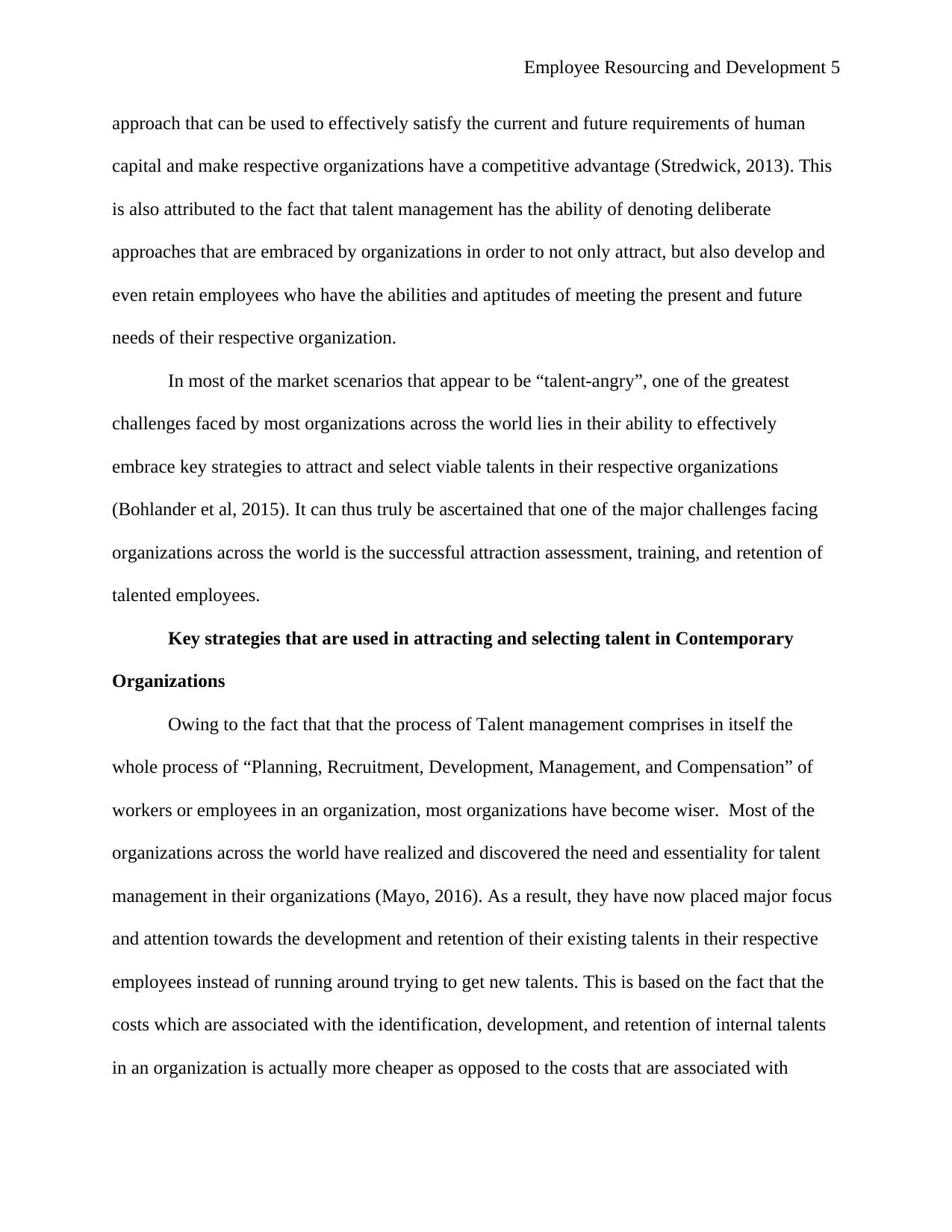
Employee Resourcing and Development 5
approach that can be used to effectively satisfy the current and future requirements of human
capital and make respective organizations have a competitive advantage (Stredwick, 2013). This
is also attributed to the fact that talent management has the ability of denoting deliberate
approaches that are embraced by organizations in order to not only attract, but also develop and
even retain employees who have the abilities and aptitudes of meeting the present and future
needs of their respective organization.
In most of the market scenarios that appear to be “talent-angry”, one of the greatest
challenges faced by most organizations across the world lies in their ability to effectively
embrace key strategies to attract and select viable talents in their respective organizations
(Bohlander et al, 2015). It can thus truly be ascertained that one of the major challenges facing
organizations across the world is the successful attraction assessment, training, and retention of
talented employees.
Key strategies that are used in attracting and selecting talent in Contemporary
Organizations
Owing to the fact that that the process of Talent management comprises in itself the
whole process of “Planning, Recruitment, Development, Management, and Compensation” of
workers or employees in an organization, most organizations have become wiser. Most of the
organizations across the world have realized and discovered the need and essentiality for talent
management in their organizations (Mayo, 2016). As a result, they have now placed major focus
and attention towards the development and retention of their existing talents in their respective
employees instead of running around trying to get new talents. This is based on the fact that the
costs which are associated with the identification, development, and retention of internal talents
in an organization is actually more cheaper as opposed to the costs that are associated with
approach that can be used to effectively satisfy the current and future requirements of human
capital and make respective organizations have a competitive advantage (Stredwick, 2013). This
is also attributed to the fact that talent management has the ability of denoting deliberate
approaches that are embraced by organizations in order to not only attract, but also develop and
even retain employees who have the abilities and aptitudes of meeting the present and future
needs of their respective organization.
In most of the market scenarios that appear to be “talent-angry”, one of the greatest
challenges faced by most organizations across the world lies in their ability to effectively
embrace key strategies to attract and select viable talents in their respective organizations
(Bohlander et al, 2015). It can thus truly be ascertained that one of the major challenges facing
organizations across the world is the successful attraction assessment, training, and retention of
talented employees.
Key strategies that are used in attracting and selecting talent in Contemporary
Organizations
Owing to the fact that that the process of Talent management comprises in itself the
whole process of “Planning, Recruitment, Development, Management, and Compensation” of
workers or employees in an organization, most organizations have become wiser. Most of the
organizations across the world have realized and discovered the need and essentiality for talent
management in their organizations (Mayo, 2016). As a result, they have now placed major focus
and attention towards the development and retention of their existing talents in their respective
employees instead of running around trying to get new talents. This is based on the fact that the
costs which are associated with the identification, development, and retention of internal talents
in an organization is actually more cheaper as opposed to the costs that are associated with
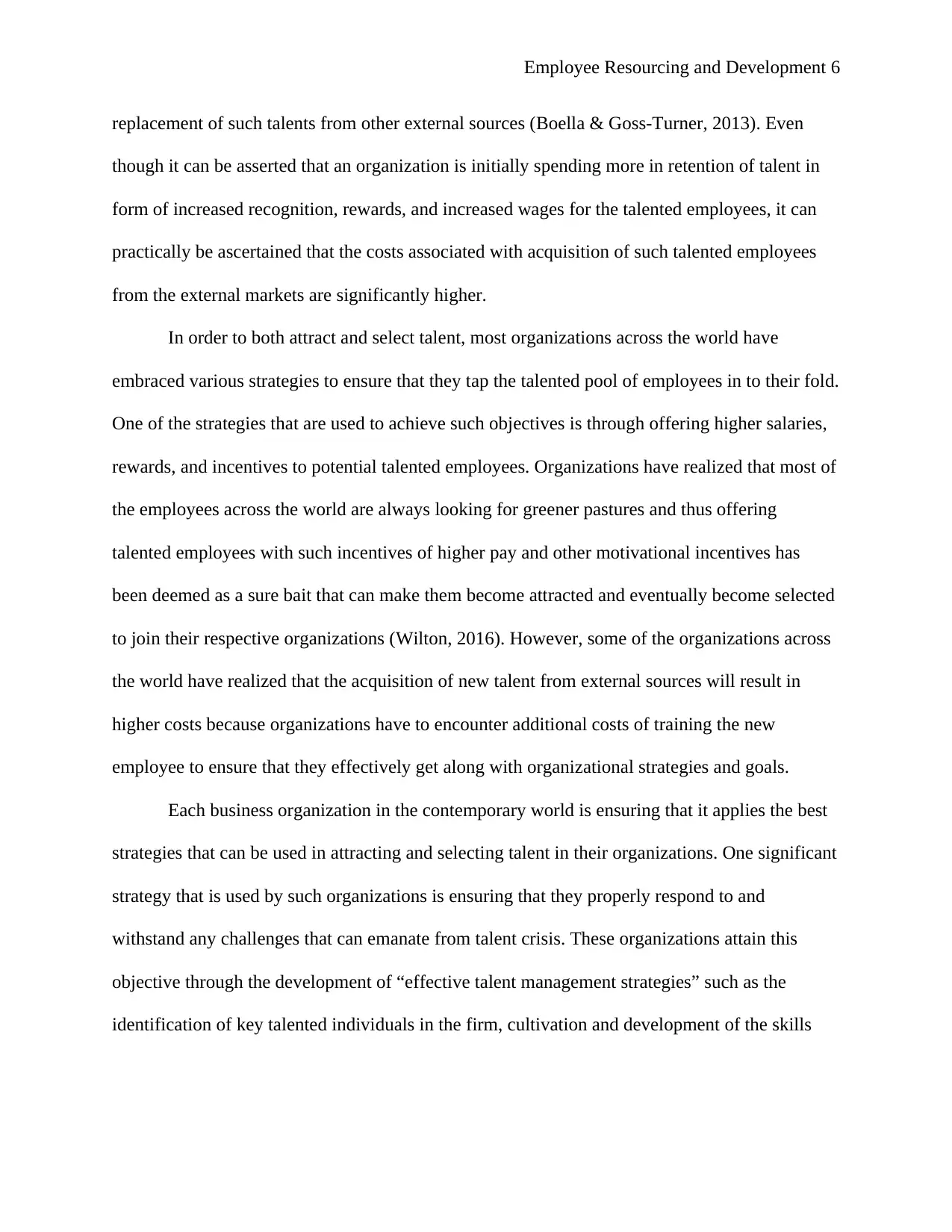
Employee Resourcing and Development 6
replacement of such talents from other external sources (Boella & Goss-Turner, 2013). Even
though it can be asserted that an organization is initially spending more in retention of talent in
form of increased recognition, rewards, and increased wages for the talented employees, it can
practically be ascertained that the costs associated with acquisition of such talented employees
from the external markets are significantly higher.
In order to both attract and select talent, most organizations across the world have
embraced various strategies to ensure that they tap the talented pool of employees in to their fold.
One of the strategies that are used to achieve such objectives is through offering higher salaries,
rewards, and incentives to potential talented employees. Organizations have realized that most of
the employees across the world are always looking for greener pastures and thus offering
talented employees with such incentives of higher pay and other motivational incentives has
been deemed as a sure bait that can make them become attracted and eventually become selected
to join their respective organizations (Wilton, 2016). However, some of the organizations across
the world have realized that the acquisition of new talent from external sources will result in
higher costs because organizations have to encounter additional costs of training the new
employee to ensure that they effectively get along with organizational strategies and goals.
Each business organization in the contemporary world is ensuring that it applies the best
strategies that can be used in attracting and selecting talent in their organizations. One significant
strategy that is used by such organizations is ensuring that they properly respond to and
withstand any challenges that can emanate from talent crisis. These organizations attain this
objective through the development of “effective talent management strategies” such as the
identification of key talented individuals in the firm, cultivation and development of the skills
replacement of such talents from other external sources (Boella & Goss-Turner, 2013). Even
though it can be asserted that an organization is initially spending more in retention of talent in
form of increased recognition, rewards, and increased wages for the talented employees, it can
practically be ascertained that the costs associated with acquisition of such talented employees
from the external markets are significantly higher.
In order to both attract and select talent, most organizations across the world have
embraced various strategies to ensure that they tap the talented pool of employees in to their fold.
One of the strategies that are used to achieve such objectives is through offering higher salaries,
rewards, and incentives to potential talented employees. Organizations have realized that most of
the employees across the world are always looking for greener pastures and thus offering
talented employees with such incentives of higher pay and other motivational incentives has
been deemed as a sure bait that can make them become attracted and eventually become selected
to join their respective organizations (Wilton, 2016). However, some of the organizations across
the world have realized that the acquisition of new talent from external sources will result in
higher costs because organizations have to encounter additional costs of training the new
employee to ensure that they effectively get along with organizational strategies and goals.
Each business organization in the contemporary world is ensuring that it applies the best
strategies that can be used in attracting and selecting talent in their organizations. One significant
strategy that is used by such organizations is ensuring that they properly respond to and
withstand any challenges that can emanate from talent crisis. These organizations attain this
objective through the development of “effective talent management strategies” such as the
identification of key talented individuals in the firm, cultivation and development of the skills
⊘ This is a preview!⊘
Do you want full access?
Subscribe today to unlock all pages.

Trusted by 1+ million students worldwide
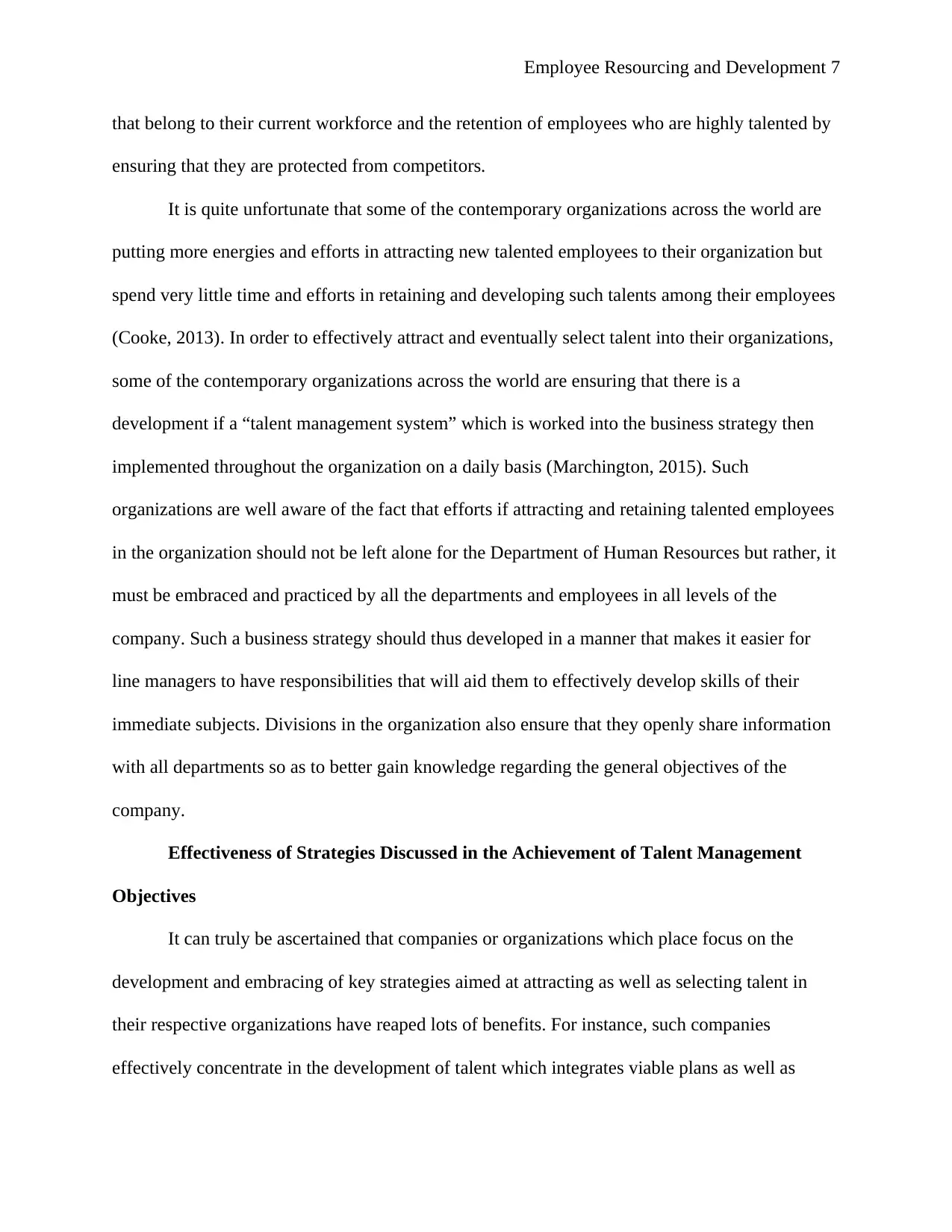
Employee Resourcing and Development 7
that belong to their current workforce and the retention of employees who are highly talented by
ensuring that they are protected from competitors.
It is quite unfortunate that some of the contemporary organizations across the world are
putting more energies and efforts in attracting new talented employees to their organization but
spend very little time and efforts in retaining and developing such talents among their employees
(Cooke, 2013). In order to effectively attract and eventually select talent into their organizations,
some of the contemporary organizations across the world are ensuring that there is a
development if a “talent management system” which is worked into the business strategy then
implemented throughout the organization on a daily basis (Marchington, 2015). Such
organizations are well aware of the fact that efforts if attracting and retaining talented employees
in the organization should not be left alone for the Department of Human Resources but rather, it
must be embraced and practiced by all the departments and employees in all levels of the
company. Such a business strategy should thus developed in a manner that makes it easier for
line managers to have responsibilities that will aid them to effectively develop skills of their
immediate subjects. Divisions in the organization also ensure that they openly share information
with all departments so as to better gain knowledge regarding the general objectives of the
company.
Effectiveness of Strategies Discussed in the Achievement of Talent Management
Objectives
It can truly be ascertained that companies or organizations which place focus on the
development and embracing of key strategies aimed at attracting as well as selecting talent in
their respective organizations have reaped lots of benefits. For instance, such companies
effectively concentrate in the development of talent which integrates viable plans as well as
that belong to their current workforce and the retention of employees who are highly talented by
ensuring that they are protected from competitors.
It is quite unfortunate that some of the contemporary organizations across the world are
putting more energies and efforts in attracting new talented employees to their organization but
spend very little time and efforts in retaining and developing such talents among their employees
(Cooke, 2013). In order to effectively attract and eventually select talent into their organizations,
some of the contemporary organizations across the world are ensuring that there is a
development if a “talent management system” which is worked into the business strategy then
implemented throughout the organization on a daily basis (Marchington, 2015). Such
organizations are well aware of the fact that efforts if attracting and retaining talented employees
in the organization should not be left alone for the Department of Human Resources but rather, it
must be embraced and practiced by all the departments and employees in all levels of the
company. Such a business strategy should thus developed in a manner that makes it easier for
line managers to have responsibilities that will aid them to effectively develop skills of their
immediate subjects. Divisions in the organization also ensure that they openly share information
with all departments so as to better gain knowledge regarding the general objectives of the
company.
Effectiveness of Strategies Discussed in the Achievement of Talent Management
Objectives
It can truly be ascertained that companies or organizations which place focus on the
development and embracing of key strategies aimed at attracting as well as selecting talent in
their respective organizations have reaped lots of benefits. For instance, such companies
effectively concentrate in the development of talent which integrates viable plans as well as
Paraphrase This Document
Need a fresh take? Get an instant paraphrase of this document with our AI Paraphraser

Employee Resourcing and Development 8
processes that are used in tracking and managing the talents of their respective employees. This
is achieved through various ways which includes among others sourcing, attraction, recruiting,
and bringing on board candidates who are not only well qualified, but also have competitive
advantage (Collings et al, 2012). By using employees which the organization is using in order to
enhance talents, an organization is in a better position of both managing and even defining
competitive salaries as opposed to situations when they have to bring on board talented
employees from other organizations.
Using current or internal employees in attracting and selecting talent in an organization is
more effective as opposed to hiring talent from external sources because such organizations safe
more resources because apart from the fact that they are in a better position of managing and
defining competitive salaries, they also save lots of finance that could have been used in training
as well as development chances or opportunities for the new talented employees. Using of the
current organizational employees in attracting and selecting talent by contemporary
organizations is quite beneficial for them in that they make it easier for an organization to use
retention programs and makes promotion and even transitions go on smoothly without
interruptions or complaints.
Based on the above information, it can truly be asserted that Talent Management should
never be underscored by any contemporary organization. This is based on the fact that Talent
management is an important new approach in the Human Resource Management field that can
effectively be embraced to ensure that both the present and future human capital of an
organization is fully satisfied. As a result, the argument which is held by Human Resource
Practitioners and academics that Talent management helps in equipping an organization with
suitable employees that can better deal with challenges of the contemporary modern business
processes that are used in tracking and managing the talents of their respective employees. This
is achieved through various ways which includes among others sourcing, attraction, recruiting,
and bringing on board candidates who are not only well qualified, but also have competitive
advantage (Collings et al, 2012). By using employees which the organization is using in order to
enhance talents, an organization is in a better position of both managing and even defining
competitive salaries as opposed to situations when they have to bring on board talented
employees from other organizations.
Using current or internal employees in attracting and selecting talent in an organization is
more effective as opposed to hiring talent from external sources because such organizations safe
more resources because apart from the fact that they are in a better position of managing and
defining competitive salaries, they also save lots of finance that could have been used in training
as well as development chances or opportunities for the new talented employees. Using of the
current organizational employees in attracting and selecting talent by contemporary
organizations is quite beneficial for them in that they make it easier for an organization to use
retention programs and makes promotion and even transitions go on smoothly without
interruptions or complaints.
Based on the above information, it can truly be asserted that Talent Management should
never be underscored by any contemporary organization. This is based on the fact that Talent
management is an important new approach in the Human Resource Management field that can
effectively be embraced to ensure that both the present and future human capital of an
organization is fully satisfied. As a result, the argument which is held by Human Resource
Practitioners and academics that Talent management helps in equipping an organization with
suitable employees that can better deal with challenges of the contemporary modern business
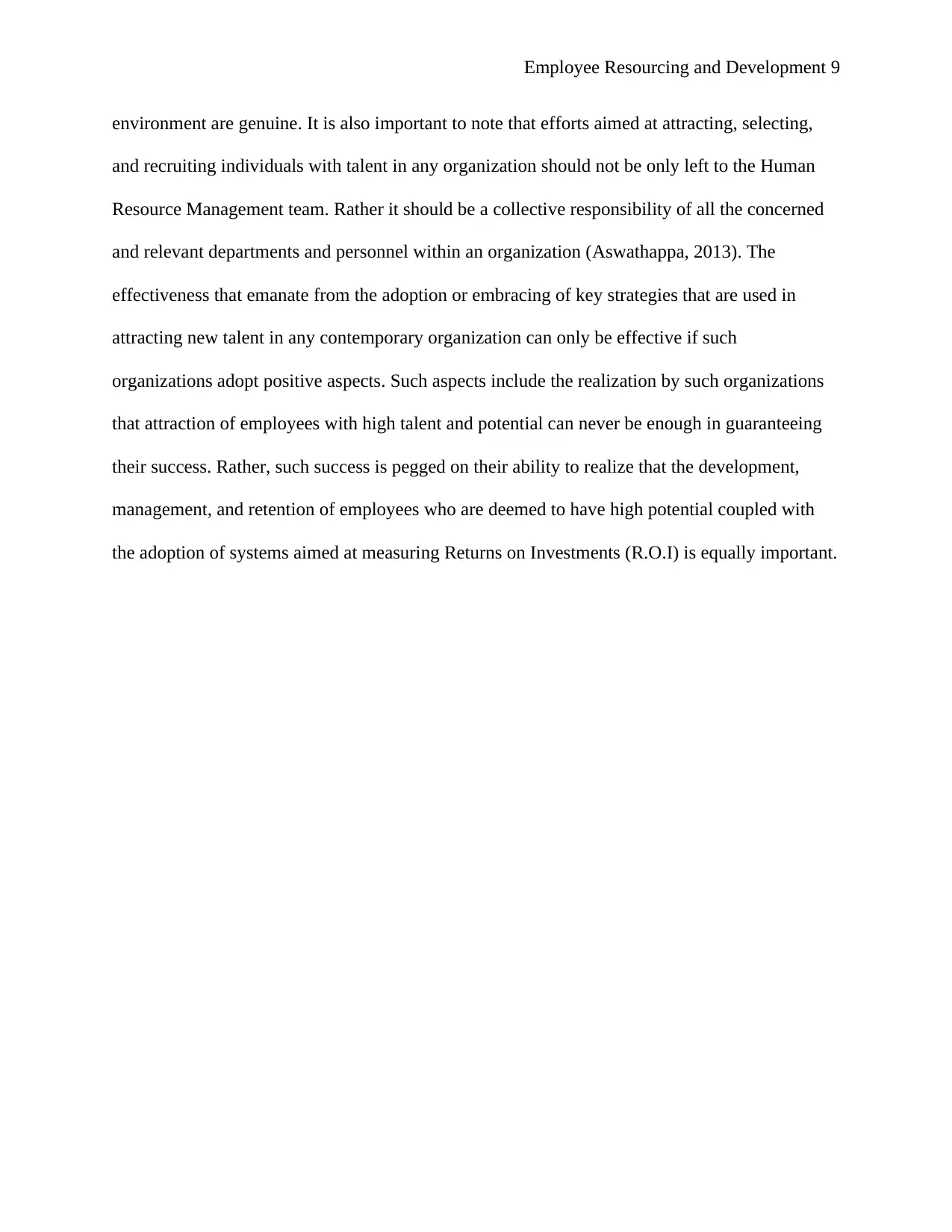
Employee Resourcing and Development 9
environment are genuine. It is also important to note that efforts aimed at attracting, selecting,
and recruiting individuals with talent in any organization should not be only left to the Human
Resource Management team. Rather it should be a collective responsibility of all the concerned
and relevant departments and personnel within an organization (Aswathappa, 2013). The
effectiveness that emanate from the adoption or embracing of key strategies that are used in
attracting new talent in any contemporary organization can only be effective if such
organizations adopt positive aspects. Such aspects include the realization by such organizations
that attraction of employees with high talent and potential can never be enough in guaranteeing
their success. Rather, such success is pegged on their ability to realize that the development,
management, and retention of employees who are deemed to have high potential coupled with
the adoption of systems aimed at measuring Returns on Investments (R.O.I) is equally important.
environment are genuine. It is also important to note that efforts aimed at attracting, selecting,
and recruiting individuals with talent in any organization should not be only left to the Human
Resource Management team. Rather it should be a collective responsibility of all the concerned
and relevant departments and personnel within an organization (Aswathappa, 2013). The
effectiveness that emanate from the adoption or embracing of key strategies that are used in
attracting new talent in any contemporary organization can only be effective if such
organizations adopt positive aspects. Such aspects include the realization by such organizations
that attraction of employees with high talent and potential can never be enough in guaranteeing
their success. Rather, such success is pegged on their ability to realize that the development,
management, and retention of employees who are deemed to have high potential coupled with
the adoption of systems aimed at measuring Returns on Investments (R.O.I) is equally important.
⊘ This is a preview!⊘
Do you want full access?
Subscribe today to unlock all pages.

Trusted by 1+ million students worldwide
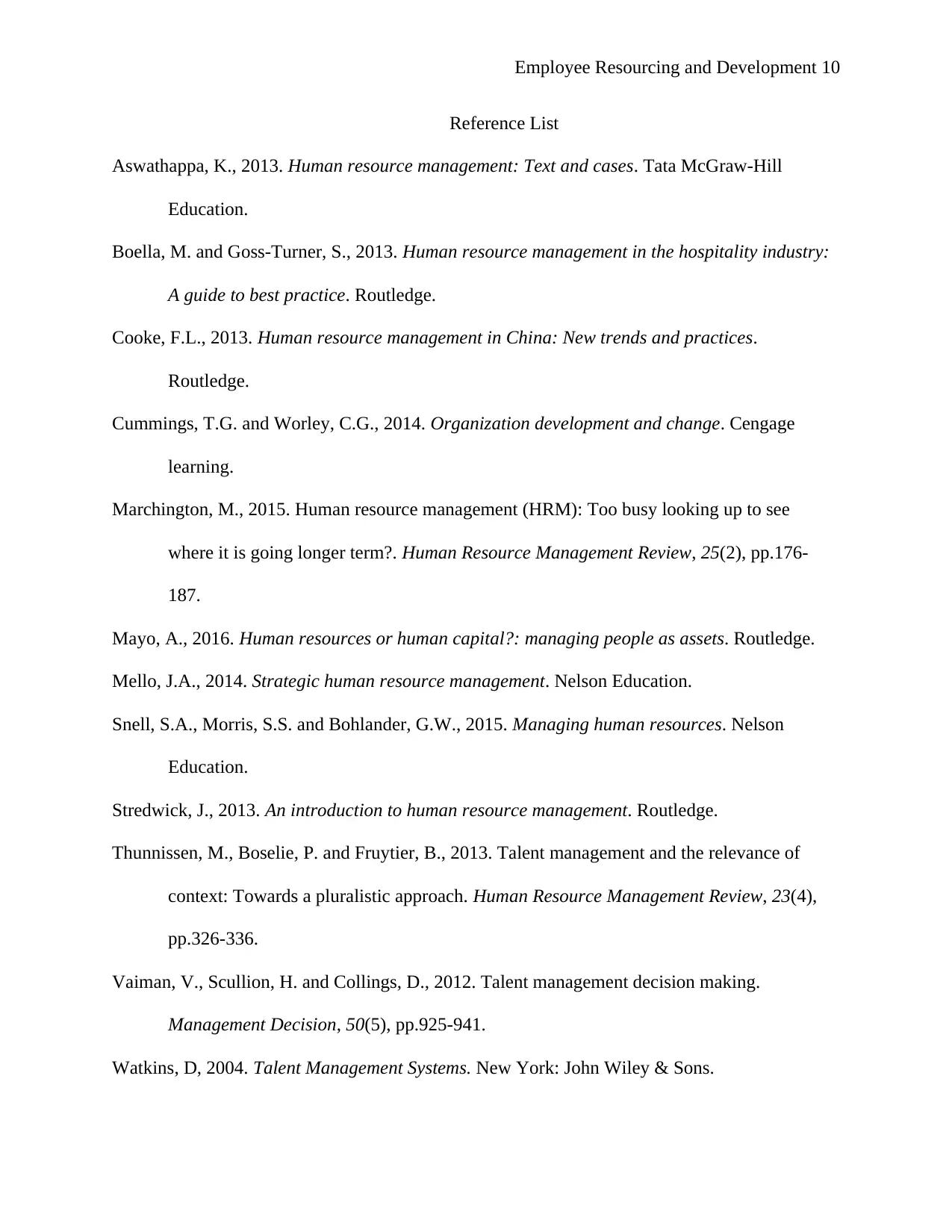
Employee Resourcing and Development 10
Reference List
Aswathappa, K., 2013. Human resource management: Text and cases. Tata McGraw-Hill
Education.
Boella, M. and Goss-Turner, S., 2013. Human resource management in the hospitality industry:
A guide to best practice. Routledge.
Cooke, F.L., 2013. Human resource management in China: New trends and practices.
Routledge.
Cummings, T.G. and Worley, C.G., 2014. Organization development and change. Cengage
learning.
Marchington, M., 2015. Human resource management (HRM): Too busy looking up to see
where it is going longer term?. Human Resource Management Review, 25(2), pp.176-
187.
Mayo, A., 2016. Human resources or human capital?: managing people as assets. Routledge.
Mello, J.A., 2014. Strategic human resource management. Nelson Education.
Snell, S.A., Morris, S.S. and Bohlander, G.W., 2015. Managing human resources. Nelson
Education.
Stredwick, J., 2013. An introduction to human resource management. Routledge.
Thunnissen, M., Boselie, P. and Fruytier, B., 2013. Talent management and the relevance of
context: Towards a pluralistic approach. Human Resource Management Review, 23(4),
pp.326-336.
Vaiman, V., Scullion, H. and Collings, D., 2012. Talent management decision making.
Management Decision, 50(5), pp.925-941.
Watkins, D, 2004. Talent Management Systems. New York: John Wiley & Sons.
Reference List
Aswathappa, K., 2013. Human resource management: Text and cases. Tata McGraw-Hill
Education.
Boella, M. and Goss-Turner, S., 2013. Human resource management in the hospitality industry:
A guide to best practice. Routledge.
Cooke, F.L., 2013. Human resource management in China: New trends and practices.
Routledge.
Cummings, T.G. and Worley, C.G., 2014. Organization development and change. Cengage
learning.
Marchington, M., 2015. Human resource management (HRM): Too busy looking up to see
where it is going longer term?. Human Resource Management Review, 25(2), pp.176-
187.
Mayo, A., 2016. Human resources or human capital?: managing people as assets. Routledge.
Mello, J.A., 2014. Strategic human resource management. Nelson Education.
Snell, S.A., Morris, S.S. and Bohlander, G.W., 2015. Managing human resources. Nelson
Education.
Stredwick, J., 2013. An introduction to human resource management. Routledge.
Thunnissen, M., Boselie, P. and Fruytier, B., 2013. Talent management and the relevance of
context: Towards a pluralistic approach. Human Resource Management Review, 23(4),
pp.326-336.
Vaiman, V., Scullion, H. and Collings, D., 2012. Talent management decision making.
Management Decision, 50(5), pp.925-941.
Watkins, D, 2004. Talent Management Systems. New York: John Wiley & Sons.
Paraphrase This Document
Need a fresh take? Get an instant paraphrase of this document with our AI Paraphraser

Employee Resourcing and Development 11
Wilton, N., 2016. An introduction to human resource management. Sage.
Wilton, N., 2016. An introduction to human resource management. Sage.
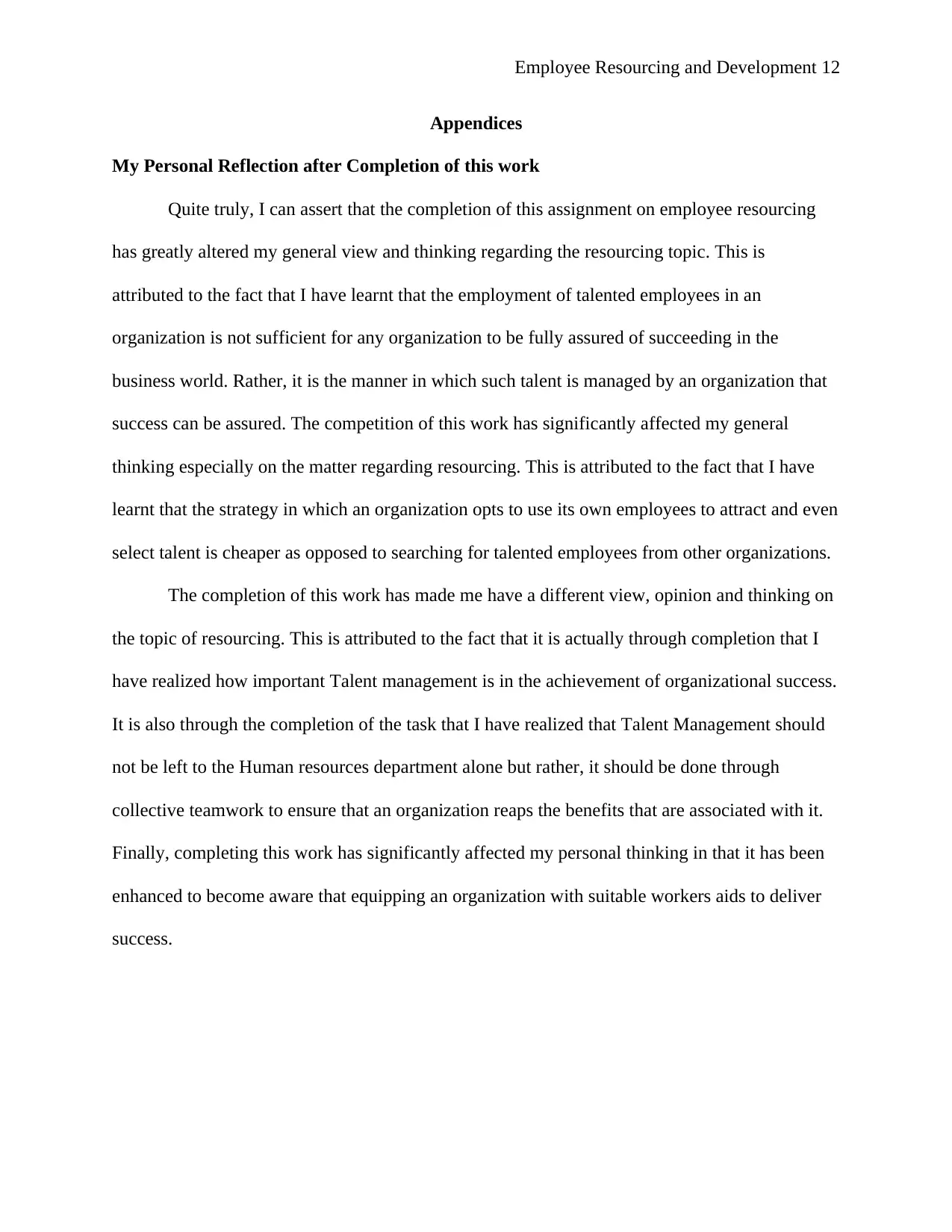
Employee Resourcing and Development 12
Appendices
My Personal Reflection after Completion of this work
Quite truly, I can assert that the completion of this assignment on employee resourcing
has greatly altered my general view and thinking regarding the resourcing topic. This is
attributed to the fact that I have learnt that the employment of talented employees in an
organization is not sufficient for any organization to be fully assured of succeeding in the
business world. Rather, it is the manner in which such talent is managed by an organization that
success can be assured. The competition of this work has significantly affected my general
thinking especially on the matter regarding resourcing. This is attributed to the fact that I have
learnt that the strategy in which an organization opts to use its own employees to attract and even
select talent is cheaper as opposed to searching for talented employees from other organizations.
The completion of this work has made me have a different view, opinion and thinking on
the topic of resourcing. This is attributed to the fact that it is actually through completion that I
have realized how important Talent management is in the achievement of organizational success.
It is also through the completion of the task that I have realized that Talent Management should
not be left to the Human resources department alone but rather, it should be done through
collective teamwork to ensure that an organization reaps the benefits that are associated with it.
Finally, completing this work has significantly affected my personal thinking in that it has been
enhanced to become aware that equipping an organization with suitable workers aids to deliver
success.
Appendices
My Personal Reflection after Completion of this work
Quite truly, I can assert that the completion of this assignment on employee resourcing
has greatly altered my general view and thinking regarding the resourcing topic. This is
attributed to the fact that I have learnt that the employment of talented employees in an
organization is not sufficient for any organization to be fully assured of succeeding in the
business world. Rather, it is the manner in which such talent is managed by an organization that
success can be assured. The competition of this work has significantly affected my general
thinking especially on the matter regarding resourcing. This is attributed to the fact that I have
learnt that the strategy in which an organization opts to use its own employees to attract and even
select talent is cheaper as opposed to searching for talented employees from other organizations.
The completion of this work has made me have a different view, opinion and thinking on
the topic of resourcing. This is attributed to the fact that it is actually through completion that I
have realized how important Talent management is in the achievement of organizational success.
It is also through the completion of the task that I have realized that Talent Management should
not be left to the Human resources department alone but rather, it should be done through
collective teamwork to ensure that an organization reaps the benefits that are associated with it.
Finally, completing this work has significantly affected my personal thinking in that it has been
enhanced to become aware that equipping an organization with suitable workers aids to deliver
success.
⊘ This is a preview!⊘
Do you want full access?
Subscribe today to unlock all pages.

Trusted by 1+ million students worldwide
1 out of 12
Related Documents
Your All-in-One AI-Powered Toolkit for Academic Success.
+13062052269
info@desklib.com
Available 24*7 on WhatsApp / Email
![[object Object]](/_next/static/media/star-bottom.7253800d.svg)
Unlock your academic potential
© 2024 | Zucol Services PVT LTD | All rights reserved.





